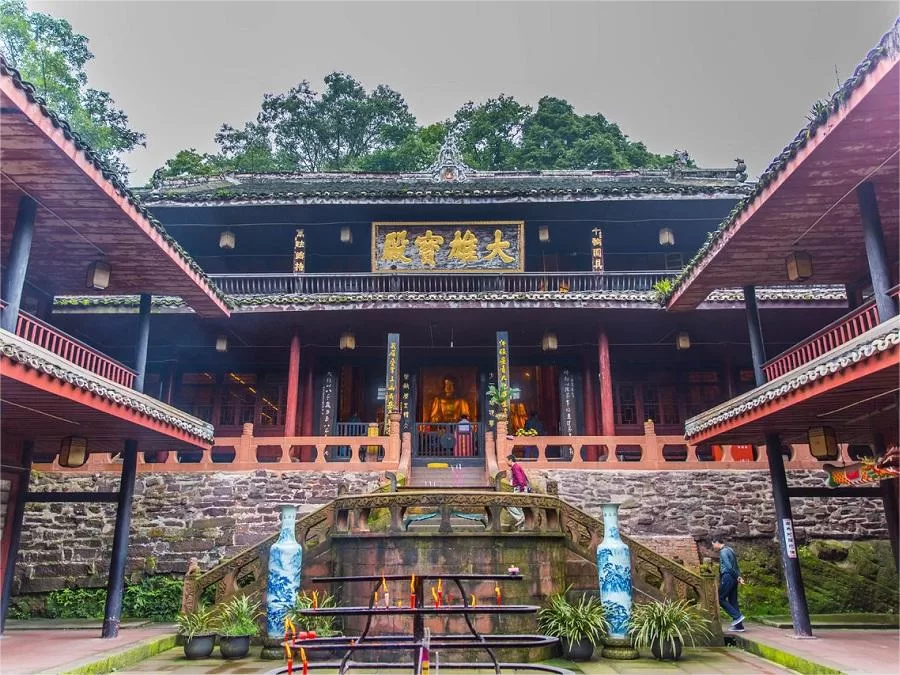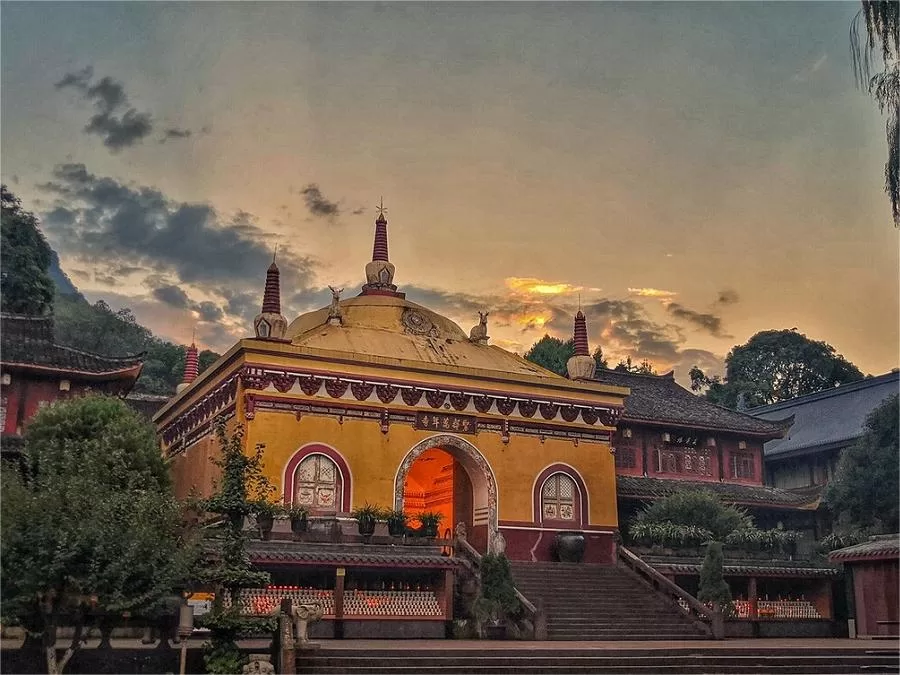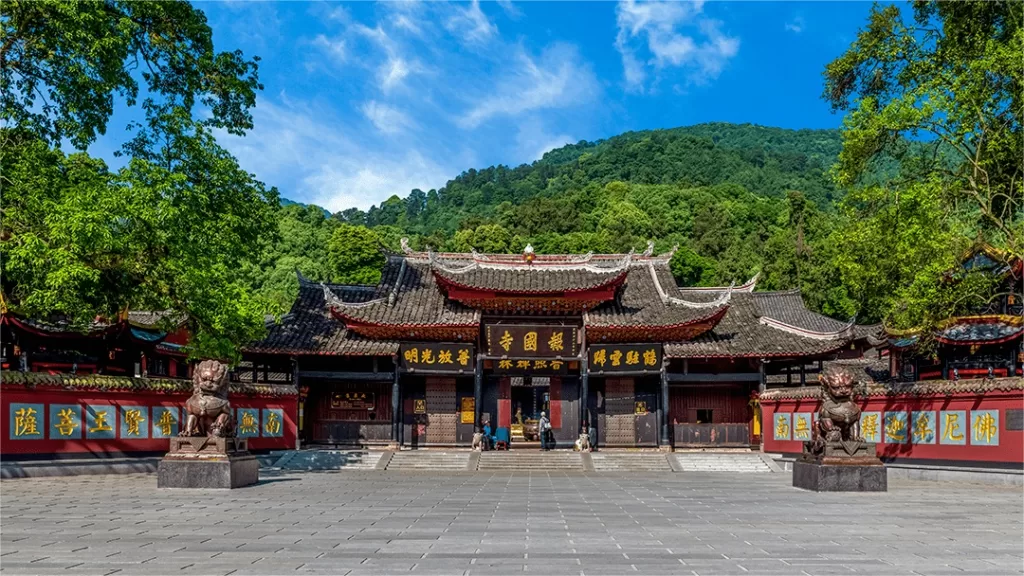Wannian Temple (万年寺), situated beneath Camel Peak in the Emeishan Scenic Area of Leshan City, Sichuan Province, stands at an elevation of 1020 meters. One of the oldest temples in Mount Emei’s history, it has deep-rooted cultural significance. Legend has it that the poet Li Bai once resided here, and a monk named Guangjun played the qin (a traditional Chinese instrument) for him. The temple houses precious artifacts like Buddha’s tooth, palm-leaf manuscripts, and relics.
In the Han Dynasty, this site served as the hermitage of the herbalist Pugong. During the Eastern Jin Dynasty (397–401 AD), the PuXian Temple was established here, later renamed Baishui Temple in the third year of the Qianfu era in the Tang Dynasty (876 AD). It was further renamed Baishui Puxian Temple during the Northern Song Dynasty. In the Ming Dynasty, Emperor Shenzong, to celebrate his mother’s birthday, ordered the construction of a remarkable brick hall, bestowing the temple with the name “Wannian Temple” (meaning “eternal longevity”). This name has persisted to the present day.
Originally consisting of 13 grand halls, Wannian Temple faced multiple fires over the years, leading to the preservation of only a few ancient structures. The current layout, including the Mountain Gate, Maitreya Hall, Prajna Hall, Potalaka Hall, Towering Hall, and Mahavira Hall, is a reconstruction and expansion carried out in 1953, covering a total area of 20,000 square meters. Wannian Temple remains a significant cultural and historical site, echoing with the centuries of Buddhist heritage on Mount Emei.
Table of Contents
- Basic Information
- Location and Transportation
- Highlights of Wannian Temple
- Vlog about Wannian Temple
- Useful Tips from Genuine Reviews
- Other Attractions in Mount Emei
Basic Information
| Estimated Length of Tour | 1 hour |
| Ticket Price | 25 RMB |
| Opening Hours | 6.00 – 18.00 (1st May – 7th October) 7.00 – 17.50 (8th October – 30th April) |
| Telephone Number | 0086-0833-5090053 |
Location and Transportation
Wannian Temple is strategically located on the western slope of Mount Emei, nestled amidst the verdant surroundings. It is situated about 28 kilometers (17 miles) from the town of Emeishan City. Unfortunately, there is no bus or tain leading there. You have to walk.
Highlights of Wannian Temple
Samantabhadra Statue

Inside the No-Beam Brick Hall at Wannian Temple, there stands a magnificent bronze statue of Samantabhadra Bodhisattva. In the fifth year of the Taiping Xingguo era during the Song Dynasty (980 AD), local officials in Sichuan repeatedly reported the appearance of Samantabhadra Bodhisattva on Mount Emei to the emperor. A devout Buddhist, the emperor issued an imperial decree, assigning officials from the Ministry of Works to Chengdu to oversee the creation of a bronze statue depicting Samantabhadra Bodhisattva riding a six-toothed white elephant.
The segmented bronze pieces were transported over three hundred miles to be assembled and enshrined in the No-Beam Brick Hall. Standing at 7.35 meters tall and weighing 62.1 tons, the statue portrays Samantabhadra Bodhisattva seated on a lotus throne atop a six-toothed white elephant. Samantabhadra Bodhisattva wears a five-Buddha crown embedded with six precious pearls, radiating a more opulent and beautiful appearance compared to ordinary Bodhisattvas. The golden lotus throne beneath is 1.3 meters high and 2.53 meters wide, adorned with a white elephant bowing with a reverent gaze, creating a striking and spiritually significant representation within Wannian Temple.
Mahavira Hall

The Grand Mahavira Hall, located behind the No-Beam Brick Hall in Wannian Temple, stands as the largest structure in the temple complex, surrounded by a corridor. It features a single-eave gable and hip roof with a waist eave in the middle, spanning five bays. The spacious design necessitated two additional pillars in the door frame. The hall is characterized by its simple color palette and unadorned architectural style. At its center, a standing statue of Amitabha Buddha is enshrined, while a statue of Wei Tuo Bodhisattva graces the back of the hall.
Non-Beam Brick Hall

The No-Beam Brick Hall in Wannian Temple stands at a height of 17.12 meters with a width of 15.79 meters and a depth of 16.06 meters. Its distinctive design features a semi-circular hollow dome top and a square base resembling a Mongolian yurt, symbolizing the unity of heaven and earth. Entirely constructed of bricks, including walls, roof, door lintels, brackets, and window frames, the hall is adorned with intricate carvings depicting the topography of Sichuan’s mountains, Cloud-Stairs Sword Gate, and the land and water routes. Inside, the walls are adorned with myriad Buddhas, while the dome ceiling showcases lively depictions of four celestial maidens playing musical instruments. Additionally, five white pagodas stand at the corners and center of the hall’s roof.
Buddhist Heritage

Wannian Temple houses a significant Buddhist relic, a purported “Buddha’s tooth,” measuring 1.28 feet long and weighing 6.5 kilograms. Originally presented by a Sri Lankan monk during the Ming Jiajing era, experts, however, have determined it to be a fossilized tooth from a sabertoothed elephant, dating back 200,000 years, rather than Gautama Buddha’s tooth. The temple also preserves the Beiyi Scriptures, where Sanskrit Buddhist scriptures are inscribed onto leaves of the Betel palm tree, endemic to the tropical rainforests of India. Measuring 50 cm in length and 12.5 cm in width across 246 pages, this scripture contains the entire text of the “Zunyi Agama Sutra,” known for its resistance to insects, decay, and fragmentation.
Vlog about Wannian Temple
Useful Tips from Genuine Reviews
Stair Climbing Considerations: The climb to Wannian Temple involves a very long staircase. It is advisable for elderly individuals to proceed slowly due to the challenging ascent.
Route to Miaoyin Pavilion: The distance from Wannian Temple to Miaoyin Pavilion is only 3 kilometers, but it involves steep downhill slopes and stairs, which can be strenuous. Visitors with lower stamina are recommended to use the cable car for a more comfortable journey.
Photography Restrictions: Photography is strictly prohibited in the majestic main hall, including both Buddha statues and any interior sections. Visitors are urged to respect this rule.
Transportation Options: Buses only reach the entrance of Wannian Temple. Visitors can choose to hike (approximately 1 hour) or take the cable car (upward fare 65 yuan, downward fare 45 yuan).
Monkey Interaction Caution: At the steps leading to Wannian Temple, many monkeys may be present. It is advised not to carry food or bags in hand as monkeys might attempt to snatch them. If carrying food, it’s better to keep it in a backpack. Additionally, avoid making loud noises when in close proximity to monkeys to prevent startling them, as this could lead to potential aggressive behavior.






